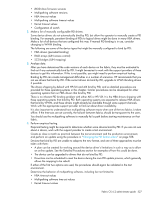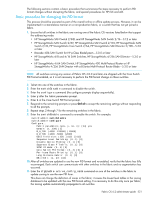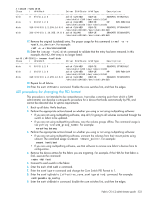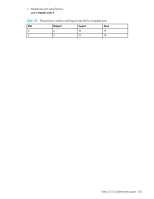HP StorageWorks 8/80 HP StorageWorks Fabric OS 6.2 administrator guide (5697-0 - Page 534
Port number to area ID conversion, PID format changes
 |
View all HP StorageWorks 8/80 manuals
Add to My Manuals
Save this manual to your list of manuals |
Page 534 highlights
Before changing the PID format, determine if host reboots will be necessary. The section "Host reboots" on page 524 summarizes the situations that may require a reboot. switch:admin> switchdisable switch:admin> configure Configure... Fabric parameters (yes, y, no, n): [no] y Domain: (1..239) [1] BB credit: (1..27) [16] R_A_TOV: (4000..120000) [10000] E_D_TOV: (1000..5000) [2000] WAN_TOV: (1000..120000) [0] Data field size: (256..2112) [2112] Sequence Level Switching: (0..1) [0] Disable Device Probing: (0..1) [0] Suppress Class F Traffic: (0..1) [0] SYNC IO mode: (0..1) [0] Switch PID Address Mode: (0..2) [1] < Set mode number here. Per-frame Route Priority: (0..1) [0] Long Distance Fabric: (0..1) [0] Port number to area ID conversion The area ID is equal to the port number except in the following cases: • When you perform a port swap operation. • When you enable Extended Edge (also known as "displaced PID") PID on the director. If you are using Extended Edge PID format (for example, the HP StorageWorks 4/256 SAN Director with configuration option 5) and would like to map the output of the port number to the area ID, use the following formula (for ports 0-127): a = (p + 16) % 128 where: a is the area, p is the port number, % is the modulus (or remainder) 0 p 128 When the port number is greater than or equal to 128, the area ID and port number are the same. PID format changes There are several routine maintenance procedures which might result in a device receiving a new PID. Examples include, but are not limited to: • Changing compatibility mode settings • Changing switch domain IDs • Merging fabrics • Relocating devices to new ports or new switches (that is, for Add, Move, Change type operations) • Updating the core PID format • Using hot spare switch ports to deal with failures In every case where devices employ static PID binding, any such procedure becomes difficult or impossible to execute without downtime. In some cases, device drivers allow you to specify static PID binding. In these cases, such devices must be identified and their PID binding should be changed to WWN binding. 530 Configuring the PID format















